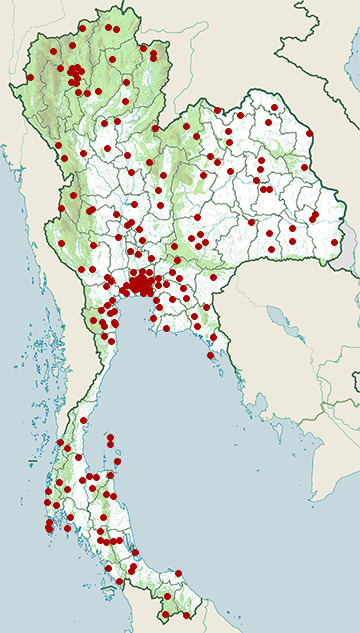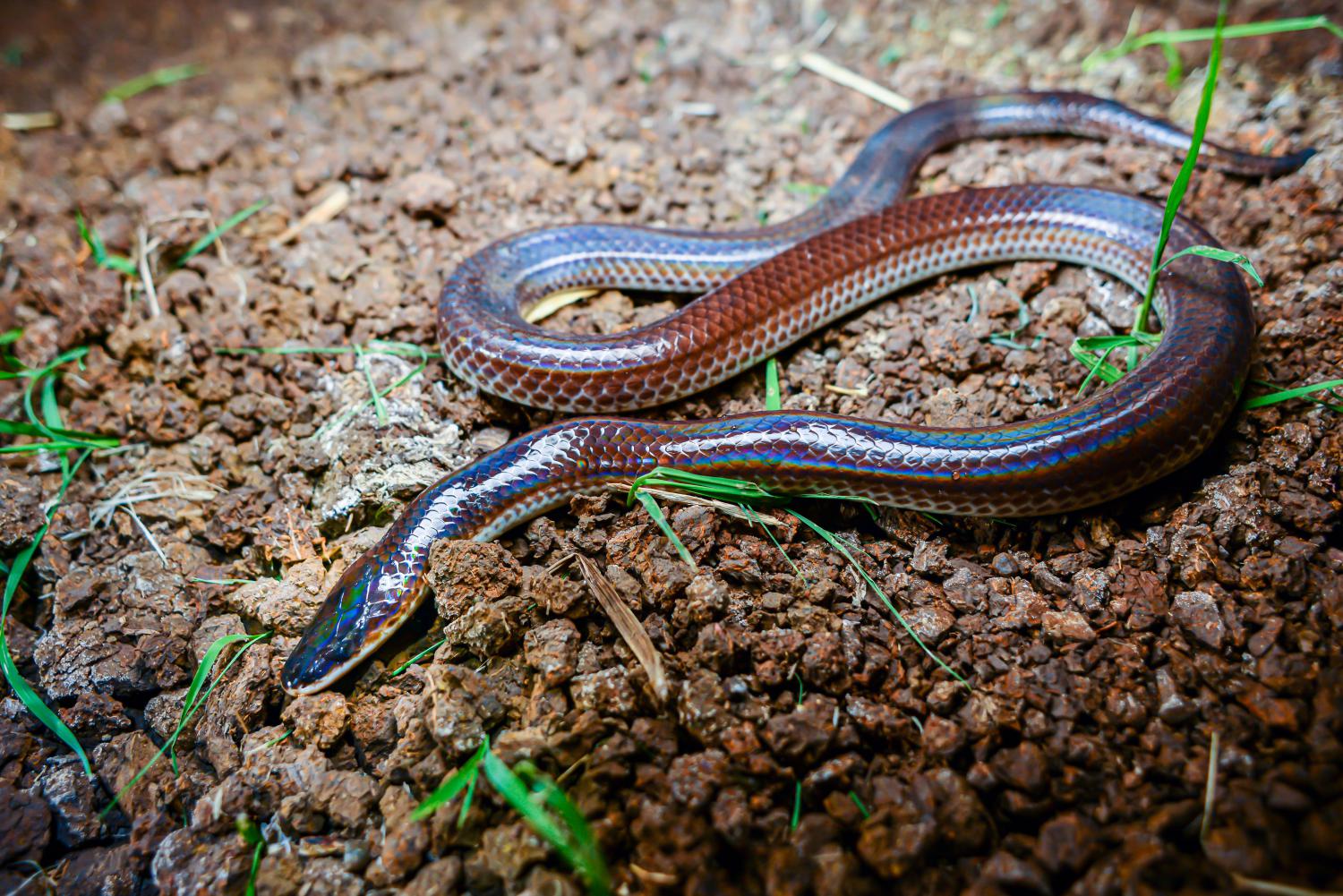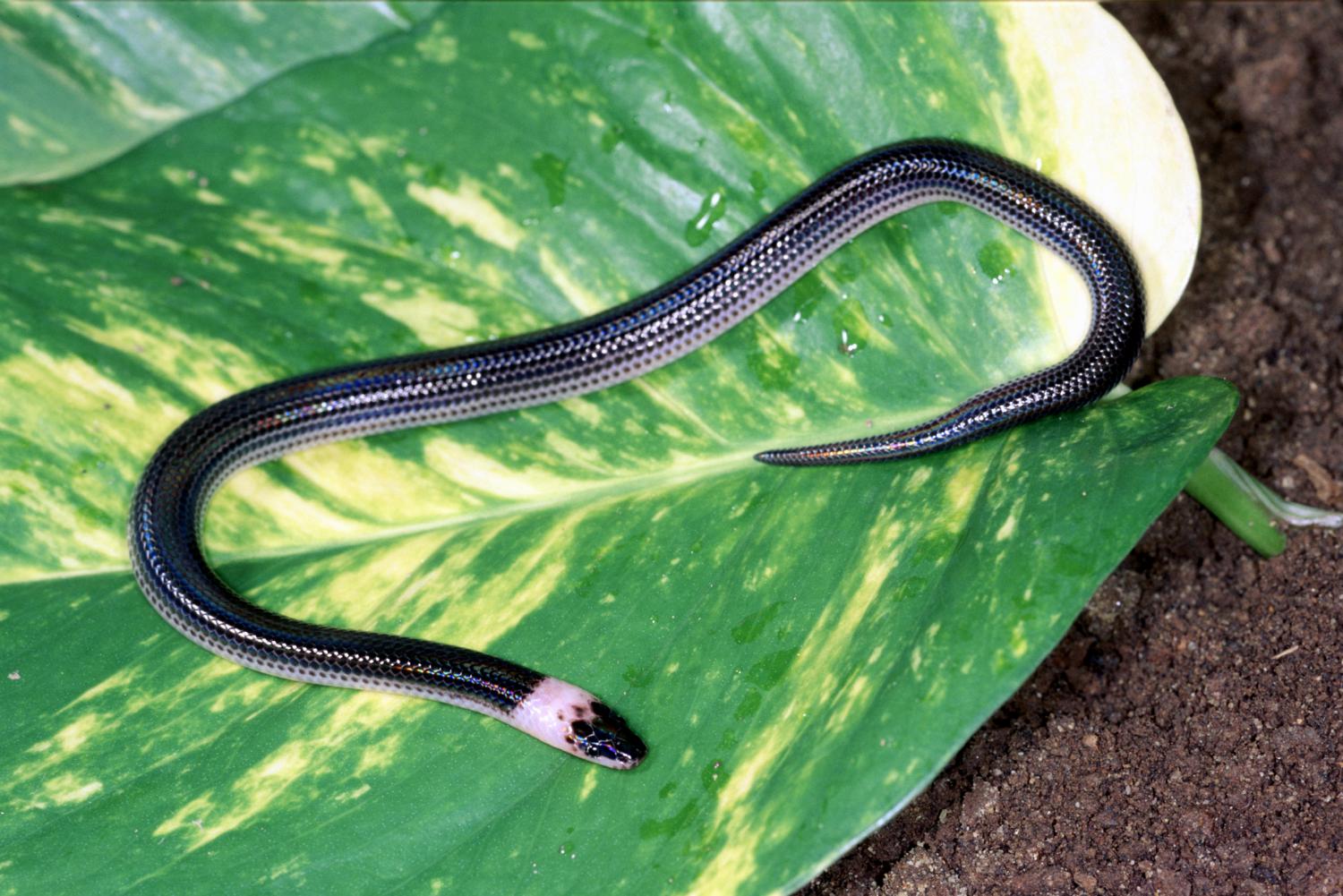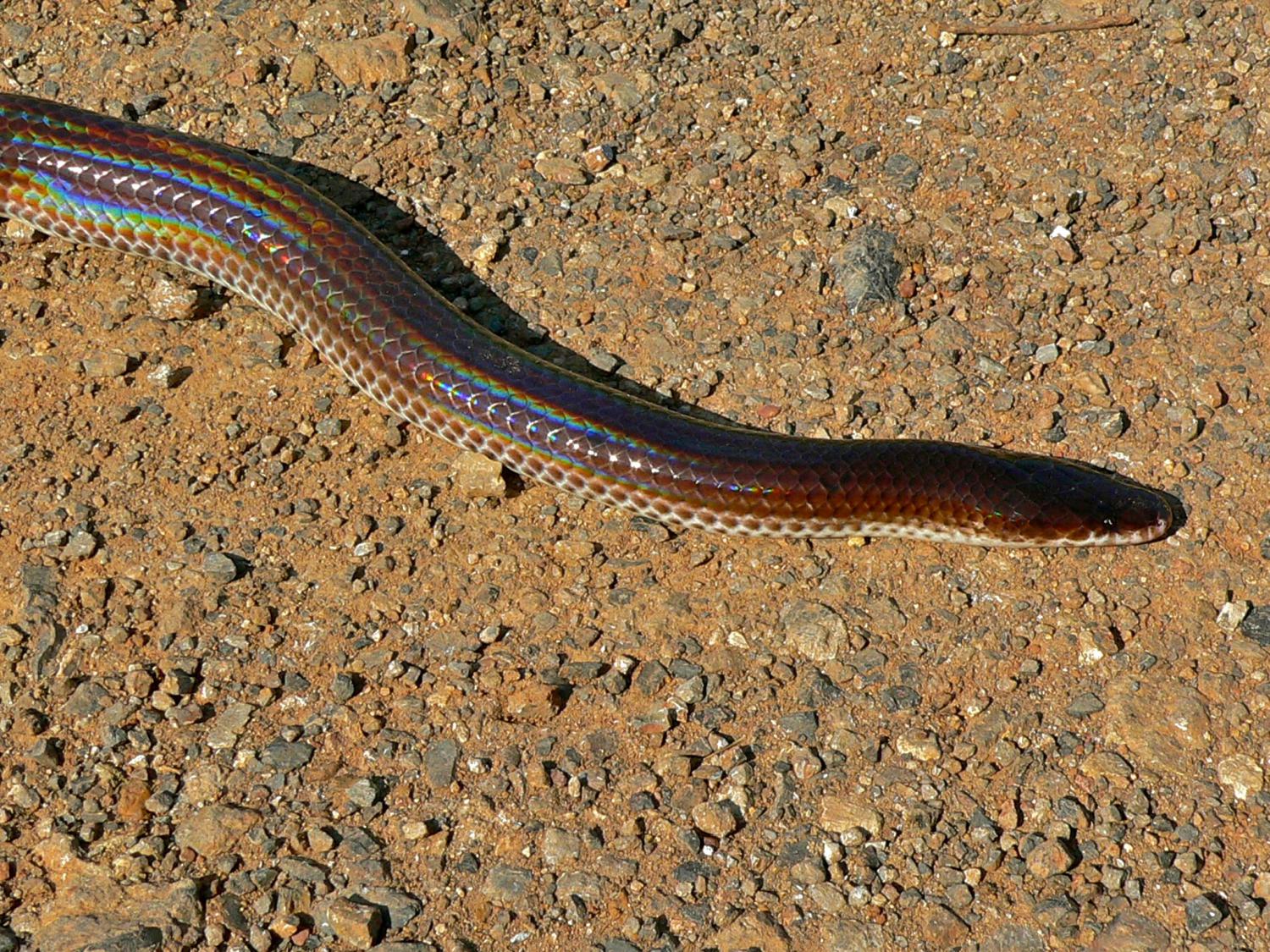Species of Thailand
Common sunbeam snake
Xenopeltis unicolor
Caspar Georg Carl Reinwardt, 1827
In Thai: งูแสงอาทิตย์, ngu saeng aatit
Xenopeltis unicolor, commonly known as the sunbeam snake, common sunbeam snake or iridescent snake, is a non-venomous sunbeam snake species found in Southeast Asia and some regions of Indonesia. This is a primitive snake known for both its highly iridescent scales and its ability to reproduce quickly, as it is oviparous and as such can lay up to 10 eggs at a time. No subspecies are currently recognized.
Description
Grows to an average of about 1 m (3 ft 3 in). A fossorial species, the head is wedge-shaped and narrow with little neck delineation, which makes it easy to push through the soil. Its most defining characteristic is its iridescent, highly polished scales that give this snake its common name. They have a layer of dark pigmentation just below the surface on each scale that enhances the iridescence. The youngs look very similar to the adults, except that they have a strong white "collar" of scales evident just below the head. This coloration fades within the first year. They have two cone opsins allowing for the potential of dichromatic color vision.,
This is a primitive form of snake with both boid and python characteristics; which family it belongs to is still a matter of debate.
Geographic range
Found in China (Guangdong and Yunnan), Myanmar, the Andaman and Nicobar Islands, Vietnam, Laos, Cambodia, Thailand, West Malaysia, Penang Island, Singapore Island, East Malaysia (Sarawak), Indonesia (the Riau Archipelago, Bangka, Billiton, Sumatra, We, Simalur, Nias, the Mentawai Islands , Borneo, Java and Sulawesi) and the Philippines (Balabac, Bongao, Jolo and Palawan). The type locality given is "Java".
Habitat
Tends to live in open areas such as forest clearings, gardens and parks. Often encountered in rice paddies.
Behavior
These snake are constrictors, killing their prey by suffocation in their muscular coils. They are fossorial and spend most of their time below ground. They may bite readily if handled roughly, but mostly just try to escape if picked up. They are also observed to vibrate their tails in a rattlesnake-like fashion when they feel threatened.
Feeding
The diet is varied, consisting primarily of frogs, reptiles, including other snakes, and small mammals.
Reproduction
Oviparous, with females laying up to 10 eggs at a time.
This article uses material from Wikipedia released under the Creative Commons Attribution-Share-Alike Licence 3.0. Eventual photos shown in this page may or may not be from Wikipedia, please see the license details for photos in photo by-lines.
Scientific classification
- Kingdom
- Animalia
- Phylum
- Chordata
- Subphylum
- Vertebrata
- Class
- Reptilia
- Order
- Squamata
- Suborder
- Serpentes
- Family
- Xenopeltidae
- Genus
- Xenopeltis
- Species
- Xenopeltis unicolor
Common names
- German: Regenbogen-Erdschlange
- English:
- Common sunbeam snake
- Asian sunbeam snake
- Sunbeam snake
- Thai: งูแสงอาทิตย์, ngu saeng aatit
Conservation status

Least Concern (IUCN3.1)
Photos
Please help us review our species pages if wrong photos are used or any other details in the page is wrong. We can be reached via our contact us page.
Range Map

- Amphawa District, Samut Songkhram
- Ban Lat District, Phetchaburi
- Ban Mi District, Lopburi
- Ban Na San District, Surat Thani
- Ban Phaeo District, Samut Sakhon
- Ban Pong District, Ratchaburi
- Bang Bo District, Samut Prakan
- Bang Khae District, Bangkok
- Bang Khen District, Bangkok
- Bang Khla District, Chachoengsao
- Bang Khun Thian District, Bangkok
- Bang Kruai District, Nonthaburi
- Bang Lamung District, Chonburi
- Bang Nam Priao District, Chachoengsao
- Bang Pahan District, Phra Nakhon Si Ayutthaya
- Bang Phli District, Samut Prakan
- Bang Sao Thong District, Samut Prakan
- Bang Yai District, Nonthaburi
- Bangkok Yai District, Bangkok
- Bannang Sata District, Yala
- Betong District, Yala
- Bueng Kum District, Bangkok
- Buntharik District, Ubon Ratchathani
- Cha-Am District, Phetchaburi
- Chiang Dao District, Chiang Mai
- Chiang Klang District, Nan
- Chok Chai District, Nakhon Ratchasima
- Doem Bang Nang Buat District, Suphan Buri
- Doi Saket District, Chiang Mai
- Doi Suthep - Pui National Park
- Don Mueang District, Bangkok
- Dusit District, Bangkok
- Erawan District, Loei
- Fang District, Chiang Mai
- Hala-Bala Wildlife Sanctuary
- Hang Chat District, Lampang
- Hat Yai District, Songkhla
- Hua Hin District, Prachuap Khiri Khan
- Huai Kha Khaeng Wildlife Sanctuary
- Huai Yot District, Trang
- Kaeng Hang Maeo District, Chanthaburi
- Kaeng Krachan District, Phetchaburi
- Kaeng Krachan National Park
- Kanchanadit District, Surat Thani
- Kathu District, Phuket
- Khanom District, Nakhon Si Thammarat
- Khao Nang Phanthurat Forest Park
- Khao Saming District, Trat
- Khao Sok National Park
- Khao Yai National Park
- Khao Yoi District, Phetchaburi
- Khlong Hoi Khong District, Songkhla
- Khlong Luang District, Pathum Thani
- Khong Chai District, Kalasin
- Khun Yuam District, Mae Hong Son
- Ko Chan District, Chonburi
- Ko Chang District, Trat
- Ko Pha-ngan District, Surat Thani
- Ko Samui District, Surat Thani
- Ko Tao
- La-ngu District, Satun
- Lan Sak District, Uthai Thani
- Lao Suea Kok District, Ubon Ratchathani
- Laplae District, Uttaradit
- Lat Krabang District, Bangkok
- Lat Lum Kaeo District, Pathum Thani
- Lat Phrao District, Bangkok
- Mae Ramat District, Tak
- Mae Rim District, Chiang Mai
- Mae Sot District, Tak
- Mae Tha, Lamphun District, Lamphun
- Min Buri District, Bangkok
- Mueang Chachoengsao District, Chachoengsao
- Mueang Chiang Mai District, Chiang Mai
- Mueang Chiang Rai District, Chiang Rai
- Mueang Chonburi District, Chonburi
- Mueang Chumphon District, Chumphon
- Mueang Kalasin District, Kalasin
- Mueang Kanchanaburi District, Kanchanaburi
- Mueang Khon Kaen District, Khon Kaen
- Mueang Krabi District, Krabi
- Mueang Lampang District, Lampang
- Mueang Lamphun District, Lamphun
- Mueang Loei District, Loei
- Mueang Lopburi District, Lopburi
- Mueang Mukdahan District, Mukdahan
- Mueang Nakhon Phanom District, Nakhon Phanom
- Mueang Nakhon Ratchasima District, Nakhon Ratchasima
- Mueang Nonthaburi District, Nonthaburi
- Mueang Phang Nga District, Phang Nga
- Mueang Phatthalung District, Phatthalung
- Mueang Phayao District, Phayao
- Mueang Phetchabun District, Phetchabun
- Mueang Phetchaburi District, Phetchaburi
- Mueang Phichit District, Phichit
- Mueang Phitsanulok District, Phitsanulok
- Mueang Phrae District, Phrae
- Mueang Phuket District, Phuket
- Mueang Prachinburi District, Prachinburi
- Mueang Ranong District, Ranong
- Mueang Rayong District, Rayong
- Mueang Roi Et District, Roi Et
- Mueang Samut Sakhon District, Samut Sakhon
- Mueang Satun District, Satun
- Mueang Sisaket District, Sisaket
- Mueang Sukhothai District, Sukhothai
- Mueang Surat Thani District, Surat Thani
- Mueang Tak District, Tak
- Mueang Trang District, Trang
- Mueang Ubon Ratchathani District, Ubon Ratchathani
- Mueang Udon Thani District, Udon Thani
- Mueang Uthai Thani District, Uthai Thani
- Na Yong District, Trang
- Nong Chok District, Bangkok
- Nong Khae District, Saraburi
- Nong Khaem District, Bangkok
- Nong Na Kham District, Khon Kaen
- Nong Phai District, Phetchabun
- Nong Prue District, Kanchanaburi
- Nong Saeng District, Udon Thani
- Nong Ya Plong District, Phetchaburi
- Nopphitam District, Nakhon Si Thammarat
- Pai District, Mae Hong Son
- Pak Chong District, Nakhon Ratchasima
- Pak Thong Chai District, Nakhon Ratchasima
- Panare District, Pattani
- Phanom District, Surat Thani
- Phato District, Chumphon
- Phi Phi Islands
- Photharam District, Ratchaburi
- Phra Khanong District, Bangkok
- Phra Pradaeng District, Samut Prakan
- Phra Thong Kham District, Nakhon Ratchasima
- Phrai Bueng District, Sisaket
- Phu Khiao District, Chaiyaphum
- Phu Suan Sai National Park
- Phu Wiang District, Khon Kaen
- Phunphin District, Surat Thani
- Pran Buri District, Prachuap Khiri Khan
- Pua District, Nan
- Sahatsakhan District, Kalasin
- Sai Mai District, Bangkok
- Sai Yok District, Kanchanaburi
- Sam Phran District, Nakhon Pathom
- Samoeng District, Chiang Mai
- Samut Prakan Province
- San Pa Tong District, Chiang Mai
- San Sai District, Chiang Mai
- Sanam Chai Khet District, Chachoengsao
- Sang Khom District, Udon Thani
- Sangkha District, Surin
- Saphan Sung District, Bangkok
- Sapphaya District, Chainat
- Saraphi District, Chiang Mai
- Satuek District, Buriram
- Seka District, Bueng Kan
- Si Chiang Mai District, Nong Khai
- Si Maha Phot District, Prachinburi
- Si Racha District, Chonburi
- Si Satchanalai District, Sukhothai
- Sikhoraphum District, Surin
- Singhanakhon District, Songkhla
- Soi Dao District, Chanthaburi
- Song District, Phrae
- Song Khwae District, Nan
- Srinagarindra District, Phatthalung
- Sung Noen District, Nakhon Ratchasima
- Takhli District, Nakhon Sawan
- Takua Pa District, Phang Nga
- Taling Chan District, Bangkok
- Tha Chana District, Surat Thani
- Tha Mai District, Chanthaburi
- Tha Maka District, Kanchanaburi
- Tha Sala District, Nakhon Si Thammarat
- Tha Takiap District, Chachoengsao
- Tha Tako District, Nakhon Sawan
- Tha Yang District, Phetchaburi
- Thai Mueang District, Phang Nga
- Thalang District, Phuket
- Thanyaburi District, Pathum Thani
- Thawat Buri District, Roi Et
- Thon Buri District, Bangkok
- Thong Pha Phum District, Kanchanaburi
- Thung Khru District, Bangkok
- Thung Salaeng Luang National Park
- Thung Song District, Nakhon Si Thammarat
- Thung Yai Naresuan Wildlife Sanctuary
- Umphang District, Tak
- Wanon Niwat District, Sakon Nakhon
- Watthana Nakhon District, Sa Kaeo
- Wiang Chai District, Chiang Rai
- Wichian Buri District, Phetchabun
- Wiset Chai Chan District, Ang Thong




